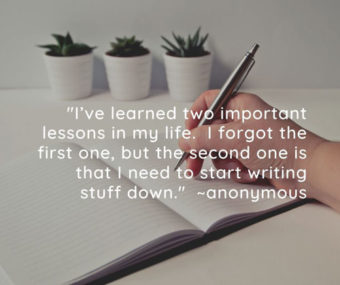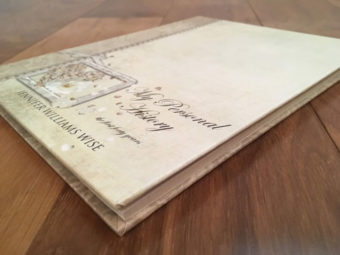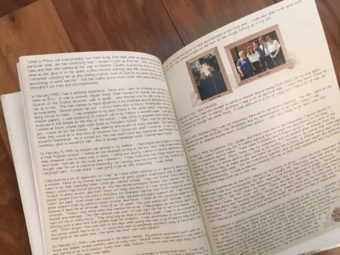An Important Part of Family History: Your Story
Posted: August 6, 2020 | By: Stacy Croninger
 I invited a long-time Heritage Makers consultant Jennifer Wise to share her thoughts on the blog this month. She is passionate about memory keeping and recording your stories.
I invited a long-time Heritage Makers consultant Jennifer Wise to share her thoughts on the blog this month. She is passionate about memory keeping and recording your stories.
– Candi May, Brand Champion for Heritage Makers

As we focus this month on family history, it might surprise you to learn that an important part of family history is your own story. Connecting with yourself first through recording your own life story gives you a starting point. It also gives you a sense of belonging, peace, and gratitude. And that’s a great way to begin a story, and as Socrates said, “to know thyself.”
Why You Need to Tell Your Story
Telling your own story has a therapeutic element to it. Putting it out there on paper validates your experiences and feelings, helps you sort through your thoughts, and allows you the amazing gift of perspective. You can choose how to tell your story and what details to include, but it’s important to bring closure, too. What lesson did you learn from it? What made you better? How have you changed things?
“Stories have to be told or they die, and when they die, we can’t remember who we are or why we’re here.” ~ Sue Monk Kidd
There’s a lesson in everything. We learn who we are. We learn what to do or what not to do. Even struggle and hard lessons develop character and strength.
Organizing your thoughts and experiences and lessons learned is a great benefit of telling your story. It’s an important key to knowing yourself. Remember my article last fall,
The Surprising Thing that Happens When You Suppress Memories
Have you ever blocked out certain memories, only to find that they are actually gone later? That’s happened to me before. I used to live in a place that I didn’t really like. I find now that when I try to remember people, places, or events from that time in my life, they’re so distant and fuzzy that they’re almost gone. It’s like it never happened. Maybe that’s why the article “Suppressing Memories May Cause Amnesia” caught my eye.
If you’ve had a bad experience, the ability to completely forget something sounds like a good idea, doesn’t it? It sounds pretty handy, actually. However, researchers found a startling result of suppressing memories.
“Researchers conclude that deliberately disengaging memory retrieval ‘broadly compromises hippocampal processes’ necessary for the creation and stabilization of new memories. As such, continually suppressing one’s recollection of certain events may prevent the hippocampus from being able to fully encode memories of other events.”
Woops. So if we block out certain memories, we might not be able to remember things we do want to remember. Telling our stories, then, opens up our brains for wonderful new things that we want to remember.
Writing Stuff Down
We don’t remember things as well if we don’t write them down and come back to re-read them. We get to laugh again, be happy again, and enjoy a moment again. What defining moments have you experienced in your life? Have you written them down?
A few years after I turned 40, I wrote the first volume of my life story called “The First Forty Years.” I have always been a journal writer, so I wrote my life story using just my journal as a resource. I basically summarized my journal, added a few thoughts, and voila. A journal is an excellent resource for a life story.
Printing Your Story
I know a man who had done the important work of writing out his life story. Unfortunately, he just left it on his computer without telling any of his children about it.
A digital file isn’t the best place to keep a life story. You just never know when a computer will crash, a laptop will get stolen, or a file will become corrupted (unreadable). So although writing stuff down is a very important part of telling your story, so is preserving it so it can be read.
 I published my first volume of my story in a Heritage Makers book. This is the 7.5×10 size. I always choose Heritage Makers because of quality and flexibility! I did type it up in a Word document first, just to have a backup document. That gave me a digital (backup) copy in addition to my beautiful hard copy. From Word, I copied and pasted into text boxes in the Heritage Makers program (Studio). Then I added a few embellishments (digital art is included in the price of the book) so that it was beautiful. Then I submitted it for publishing and had it at my door in about 10 days. I love how professional and heirloom-quality it is even though it’s essentially DIY online.
I published my first volume of my story in a Heritage Makers book. This is the 7.5×10 size. I always choose Heritage Makers because of quality and flexibility! I did type it up in a Word document first, just to have a backup document. That gave me a digital (backup) copy in addition to my beautiful hard copy. From Word, I copied and pasted into text boxes in the Heritage Makers program (Studio). Then I added a few embellishments (digital art is included in the price of the book) so that it was beautiful. Then I submitted it for publishing and had it at my door in about 10 days. I love how professional and heirloom-quality it is even though it’s essentially DIY online.
It’s For Them, But It’s For Me
Telling your story is leaving a legacy that other people can learn from. When we know each other’s stories, we are drawn to each other. We look outside ourselves. We come away with hope and an increase of gratitude. I hope that my children will appreciate reading my story some day, and I hope my grandchildren and great-grandchildren will get to know me better through this book.
 But it’s not just for them. It’s for me, too. Putting this book together helped me verbalize some life lessons and life experiences that I otherwise wouldn’t have made the effort to do. Things that bothered me didn’t bother me so much when I wrote them down. Things that were really hard experiences became things I learned. I got to put into words how I felt when I got married, when each of my children joined my life, and when I got to do things I loved.
But it’s not just for them. It’s for me, too. Putting this book together helped me verbalize some life lessons and life experiences that I otherwise wouldn’t have made the effort to do. Things that bothered me didn’t bother me so much when I wrote them down. Things that were really hard experiences became things I learned. I got to put into words how I felt when I got married, when each of my children joined my life, and when I got to do things I loved.
So write. Write your story. Write it for them, but write it for you.
Posted in:

